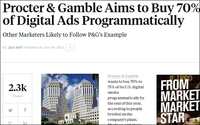Commentary
How About Now, Is This Real Enough For You?
- by Joe Mandese @mp_joemandese, June 11, 2014

Roughly a year after launching RTM Daily, we’re renaming this publication Real-Time Daily. The mission remains the same: Covering the shift toward a real-time media, advertising and marketing marketplace powered by machines, data, and of course, people. One of my goals when I originally began championing the idea internally at MediaPost was to start covering Madison Avenue the way financial press reporters cover Wall Street’s markets -- and to the extent possible, identify, develop and begin reporting on data, news and information that creates greater transparency for the advertising industry at large, not just the programmatic media trading parts of it. Look for some news on that very soon (as soon as tomorrow). In the meantime, I’d like to use today’s post as an opportunity to talk about how momentum seems to be building around the subject, especially some key developments in the past week or so.
The most noteworthy development of all was Procter & Gamble’s announcement that it plans to buy as much as 75% of its “digital media” programmatically by the end of the year. To strike another Wall Street metaphor, that news made the programmatic media marketplace rally. It did so because when P&G speaks about changes in media, it has the effect of being a rallying cry. If you doubt that, let me remind you about an early P&G rallying cry -- former CEO Ed Artzt’s speech at the 4As conference in 1994 that effectively jump-started Madison Avenue’s embrace of the Internet as a new advertising medium.
More than any other recent statement, that news has set some momentum around programmatic media buying. More than Mediabrands' bold “50% of all media by 2017” line in the sand, because even as big an influential as the Interpublic unit is, it is not the world’s biggest marketer. What struck me most about reactions to P&G’s news, was the calls I received from some extremely influential sources in big TV network companies. It got their attention, because they immediately called me to to ask what it actually means. Here’s how I replied to one who is a major player in the cable TV business, who asked me what it would mean for that medium:
“It depends on the semantics of the words ‘programmatic’ and ‘cable’,” I said, explaining, “Right now, there's not a lot of inventory for them to buy programmatically through exchanges (mainly display and some pre-roll inventory from cable nets), so that's not going to account for much of anything.
“I think [P&G] probably means a combination of things that could become significant -- using programmatic technology to facilitate buys with vendors (what we used to call eBiz of data interchange, but what everyone is now calling "private networks" or "private exchanges"). Kind of what Comcast is doing with Rubicon Project.
“And then there's programmatic audience targeting like Simulmedia, PrecisionDemand, etc., which is using data to suss out how to reach the audiences you want and buy around standard negotiating currency. (If you ask me, that's the biggest threat to suppliers, not automation.)
“And then there are alternative programmatic channels, like Visible World's AudienceXpress, which is basically an unwired network buy rolling of local cable avails.
“So without having privileged knowledge about P&G's plan, I'm going to guess it will be piecemealing the above with a goal of getting to 70%. But if they say 70%, I assume that eventually means 70% of cable TV too. I mean, they wouldn't misrepresent what they're doing, right?”
I share that conversation with you now, because I think it is a good way of thinking about the role of programmatic media trading for all media. It’s not just RTB (real-time bidding), and it’s not just about private exchanges. It’s about using machines and data to make planning, buying/trading, and evaluating the value and results of all media faster and better -- and presumably, more real-time.


